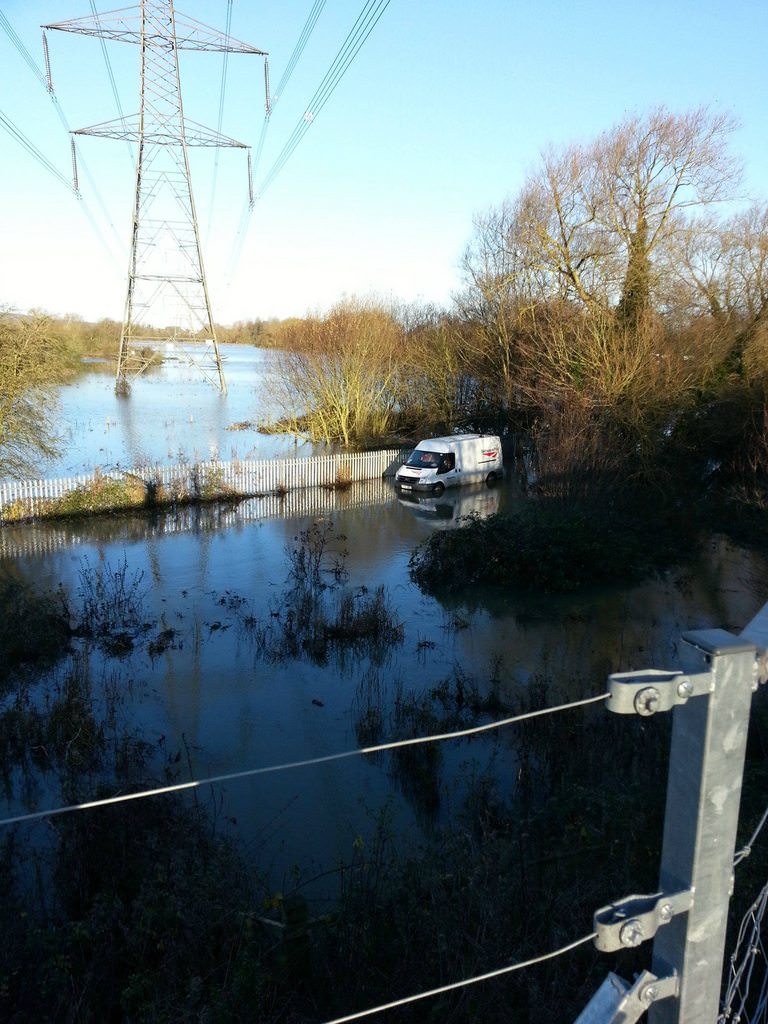RT @misterjta Dear 2012,
Fuck off. Sincerely, JTA.
Year: 2012
Owl spreading its wings [x-post from /r/pics]
This link was originally posted to /r/thesuperbowl. See more things from Dan's Reddit account.
The original link was: http://farm9.staticflickr.com/8063/8213230167_eca7b8b71b_o.jpg
Phone Security == Computer Security
The explosion of smartphone ownership over the last decade has put powerful multi-function computers into the pockets of almost half of us. But despite the fact that the average smartphone contains at least as much personally-identifiable information as its owner keeps on their home computer (or in dead-tree form) at their house – and is significantly more-prone to opportunistic theft – many users put significantly less effort into protecting their mobile’s data than they do the data they keep at home.

I have friends who religiously protect their laptops and pendrives with TrueCrypt, axCrypt, or similar, but still carry around an unencrypted mobile phone. What we’re talking about here is a device that contains all of the contact details for you and everybody you know, as well as potentially copies of all of your emails and text messages, call histories, magic cookies for social networks and other services, saved passwords, your browsing history (some people would say that’s the most-incriminating thing on their phone!), authentication apps, photos, videos… more than enough information for an attacker to pursue a highly-targeted identity theft or phishing attack.

“Pattern lock” is popular because it’s fast and convenient. It might be good enough to stop your kids from using your phone without your permission (unless they’re smart enough to do some reverse smudge engineering: looking for the smear-marks made by your fingers as you unlock the device; and let’s face it, they probably are), but it doesn’t stand up to much more than that. Furthermore, gesture unlock solutions dramatically reduce the number of permutations, because you can’t repeat a digit: so much so, that you can easily perform a rainbow table attack on the SHA1 hash to reverse-engineer somebody’s gesture. Even if Android applied a per-device psuedorandom salt to the gesture pattern (they don’t, so you can download a prefab table), it doesn’t take long to generate an SHA1 lookup of just 895,824 codes (maybe Android should have listened to Coda Hale’s advice and used BCrypt, or else something better still).
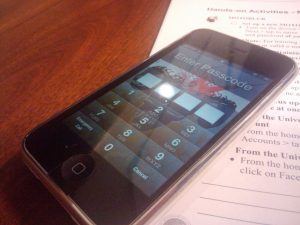
These attacks, though (and the iPhone isn’t bulletproof, either), are all rather academic, because they are trumped by the universal rule that once an attacker has physical access to your device, it is compromised. This is fundamentally the way in which mobile security should be considered to be equivalent to computer security. All of the characteristics distinct to mobile devices (portability, ubiquity, processing power, etc.) are weaknesses, and that’s why smartphones deserve at least as much protection as desktop computers protecting the same data. Mobile-specific features like “remote wipe” are worth having, but can’t be relied upon alone – a wily attacker could easily keep your phone in a lead box or otherwise disable its connectivity features until it’s cracked.
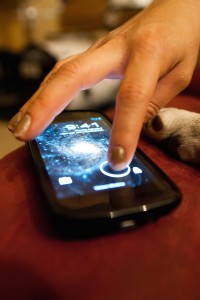
The only answer is to encrypt your device (with a good password). Having to tap in a PIN or password may be less-convenient than just “swipe to unlock”, but it gives you a system that will resist even the most-thorough efforts to break it, given physical access (last year’s iPhone 4 vulnerability notwithstanding).
It’s still not perfect – especially here in the UK, where the RIPA can be used (and has been used) to force key surrender. What we really need is meaningful, usable “whole system” mobile encryption with plausible deniability. But so long as you’re only afraid of identity thieves and phishing scammers, and not being forced to give up your password by law or under duress, then it’s “good enough”.
Of course, it’s only any use if it’s enabled before your phone gets stolen! Like backups, security is one of those things that everybody should make a habit of thinking about. Go encrypt your smartphone; it’s remarkably easy –
- Android
- iPhone – just enable PIN lock, but consider also encrypting your backups
- BlackBerry
- Windows Phone – encryption is “coming soon”, apparently.
TIL that the Malaysian government is one of few who HAVEN’T asked Google to censor satellite photos of sensitive areas, because they feel that to do so would make it MORE obvious where the sensitive areas are!
This link was originally posted to /r/todayilearned. See more things from Dan's Reddit account.
The original link was: http://web.archive.org/web/20070509182328/http://www.nst.com.my/Current_News/nst/Wednesday/National/20070328080627/Article/local1_html
MALAYSIA will not ask Google Earth to blur images of the country’s military facilities to avoid terrorist attacks. Defence Minister Datuk Seri Najib Razak said doing so would indirectly pin-point their location anyway.
“The difference in, or lack of, pixelation of images of the military facilities compared to the surrounding areas will make it easy for visual identification.” In his written reply to Datuk Dr James Dawos Mamit (BN-Mambong), Najib said the images were provided worldwide commercially.…
The Snip, Part 2
This is the second part of a three-part blog post about my vasectomy. Did you read the first part, yet?
My vasectomy was scheduled for Tuesday afternoon, so I left work early in order to cycle up to the hospital: my plan was to cycle up there, and then have Ruth ride my bike back while JTA drove me home. For a moment, though, I panicked the clinic receptionist when she saw me arrive carrying a cycle helmet and pannier bag: she assumed that I must be intending to cycle home after the operation!

It took me long enough to find the building, cycling around the hospital in the dark, and a little longer still to reassure myself that this underlit old building could actually be a place where surgery took place.

Despite my GP‘s suggestion to the contrary, the staff didn’t feel the need to take me though their counselling process, despite me ticking some (how many depends primarily upon how you perceive our unusual relationship structure) of the “we would prefer to counsel additionally” boxes on their list of criteria. I’d requested that Ruth arrive at about the beginning of the process specifically so that she could “back me up” if needed (apparently, surgeons will sometimes like to speak to the partner of a man requesting a vasectomy), but nobody even asked. I just had to sign another couple of consent forms to confirm that I really did understand what I was doing, and then I was ready to go!
I’d shaved my balls a few days earlier, at the request of the clinic (and also at Matt‘s suggestion, who pointed out that “if I don’t, they’ll do it for me, and I doubt they’ll be as gentle!” – although it must be pointed out that as they were already planning to take a blade to my junk, I might not have so much to worry about), which had turned out to be a challenge in itself. I’ve since looked online and found lots of great diagrams showing you which parts you need to shave, but the picture I’d been given might as well have been a road map of Florence, because no matter which way up I turned it, it didn’t look anything like my genitals. In the end, I just shaved all over the damn place, just to be sure. Still not an easy feat, though, because the wrinkled skin makes for challenging shaving: the best technique I found was to “stretch” my scrotum out with one hand while I shaved it with the other – a tricky (and scary) maneuver.
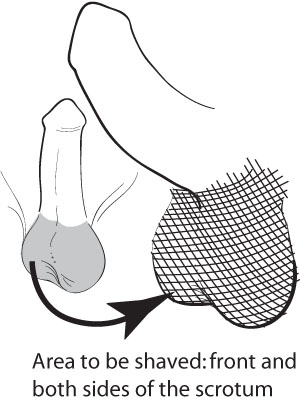
After sitting in the waiting room for a while, I was ushered through some forms and a couple more questions of “are you sure?”, and then herded into a curtained cubicle to change into a surgical gown (over the top of which I wore my usual dressing gown). The floor was cold, and I’d forgotten to bring my slippers, so I kept my socks on throughout. I sat in a separate waiting area from the first, and attempted to make small talk with the other gents waiting there. Some had just come out of surgery, and some were still waiting to go in, and the former would gently tease the latter with jokes about the operation. It’s a man thing, I guess: I can’t imagine that women would be so likely to engage in such behaviour (ignoring, for a moment, the nature of the operation).
There are several different approaches to vasectomy, and my surgeon was kind enough to tolerate my persistent questions as I asked about the specifics of each part of the operation. He’d said – after I asked – that one of the things he liked about doing vasectomies was that (unlike most of the other surgeries he performs) his patients are awake and he can have a conversation while he worked, although I guess he hadn’t anticipated that there’d ever be anybody quite so interested as I was.
Warning: The remainder of this blog post describes a surgical procedure, which some people might find squicky. For the protection of those who are of a weak stomach, some photos have been hidden behind hyperlinks: click at your own risk. (though honestly, I don’t think they’re that bad)
With my scrotum pulled up through a hole in a paper sheet, the surgeon began by checking that “everything was where it was supposed to be”: he checked that he could find each vas (if you’ve not done this: borrow the genitals of the nearest man or use your own, squeeze moderately tightly between two fingers the skin above a testicle, and move around a bit until you find a hard tube: that’s almost certainly a vas). Apparently surgeons are supposed to take care to ensure that they’ve found two distinct tubes, so they don’t for example sever the same one twice.
Next, he gave the whole thing a generous soaking in iodine. This turned out to be fucking freezing. The room was cold enough already, so I asked him to close the window while my genitals quietly shivered above the sheet.
- Iodine-soaked scrotum being injected with anaesthetic (not mine; from a medical textbook)
Next up came the injection. The local anaesthetic used for this kind of operation is pretty much identical to the kind you get at the dentist: the only difference is that if your dentist injected you here, that’d be considered a miss. While pinching the left vas between his fingertips, the surgeon squirted a stack of lidocaine into the cavity around it. And fuck me, that hurt like being kicked in the balls. Seriously: that stung quite a bit for a few minutes, until the anaesthesia kicked in and instead the whole area felt “tingly”, in that way that your lips do after dental surgery.
- Vas clamp pulling the vas to the surface (not mine; from a medical textbook)
Pinching the vas (still beneath the skin at this point) in a specially-shaped clamp, the surgeon made a puncture wound “around” it with a sharp-nosed pair of forceps, and pulled the vas clean through the hole. This was a strange sensation – I couldn’t feel any pain, but I was aware of the movement – a “tugging” against my insides.
- Vas pulled through a hole (not mine; from a medical textbook)
A quick snip removed a couple of centimetres from the middle of it (I gather that removing a section, rather than just cutting, helps to reduce the – already slim – risk that the two loose ends will grow back together again) and cauterised the ends. The cauterisation was a curious experience, because while I wasn’t aware of any sensation of heat, I could hear a sizzling sound and smell my own flesh burning. It turns out that my flaming testicles smell a little like bacon. Or, if you’d like to look at it another way (and I can almost guarantee that you don’t): bacon smells a little bit like my testicles, being singed.
Next up came Righty’s turn, but he wasn’t playing ball (pun intended). The same steps got as far as clamping and puncturing before I suddenly felt a sharp pain, getting rapidly worse. “Ow… ow… owowowowowow!” I said, possibly with a little more swearing, as the surgeon blasted another few mils of anaesthetic into my bollocks. And then a little more. And damnit: it turns out that no matter how much you’ve had injected into you already, injecting anaesthetics into your tackle always feels like a kick in the nuts for a few minutes. Grr.
-
The removed sections of my vas, on a tray (actually mine)
You can see the “kink” in each, where it was pulled out by the clamp. Also visible is the clamp itself – a cruel-looking piece of equipment, I’m sure you’ll agree! – and the discarded caps from some of the syringes that were used.
The benefit of this approach, the “no-scalpel vasectomy”, is that the puncture wounds are sufficiently small as to not need stitches. At the end of the surgery, the surgeon just stuck a plaster onto the hole and called it done. I felt a bit light-headed and wobbly-legged, so I sat on the operating table for a few minutes to compose myself before returning to the nurses’ desk for my debrief. I only spent about 20 minutes, in total, with the surgeon: I’ve spent longer (and suffered more!) at the dentist.

By the evening, the anaesthetic had worn off and I was in quite a bit of pain, again: perhaps worse than that “kick in the balls” moment when the anaesthetic was first injected, but without the relief that the anaesthetic brought! I took some paracetamol and – later – some codeine, and slept with a folded-over pillow wedged between my knees, after I discovered how easy it was to accidentally squish my sore sack whenever I shifted my position.
The day after was somewhat better. I was walking like John Wayne, but this didn’t matter because – as the nurse had suggested – I spent most of the day lying down “with my feet as high as my bottom”. She’d taken the time to explain that she can’t put a bandage nor a sling on my genitals (and that I probably wouldn’t want her to, if she could), so the correct alternative is to wear tight-fitting underwear (in place of a bandage) and keep my legs elevated (as a sling). Having seen pictures of people with painful-looking bruises and swelling as a result of not following this advice, I did so as best as I could.
Today’s the day after that: I’m still in a little pain – mostly in Righty, again, which shall henceforth be called “the troublesome testicle” – but it’s not so bad except when I forget and do something like bend over or squat or, I discovered, let my balls “hang” under their own weight, at all. But altogether, it’s been not-too-bad at all.
Or, as I put on my feedback form at the clinic: “A+++. Recommended. Would vasectomy again.”
(thanks due to Ruth, JTA, Matt, Liz, Simon, Michelle, and my mum for support, suggestions, and/or fetching things to my bed for me while I’ve been waddling around looking like John Wayne, these past two days)
Oxford Under Water
Parts of Oxford have been flooded for the last few days, and apparently the worst is yet to come. I worked from home yesterday, intimidated by the available choices of traversing flooded roads or else taking the hilly 3+ mile diversion around the problem areas, but today: I decided that it was time to man up and cycle in to the office.

Conveniently, we’ve somewhere along the way acquired a large pair of Wellington boots (we think they might have been Paul‘s, but as he’s now left Oxford without them, they’ve been sitting in our charity-shop-box). So I booted up and set out. I was yawning all the way:
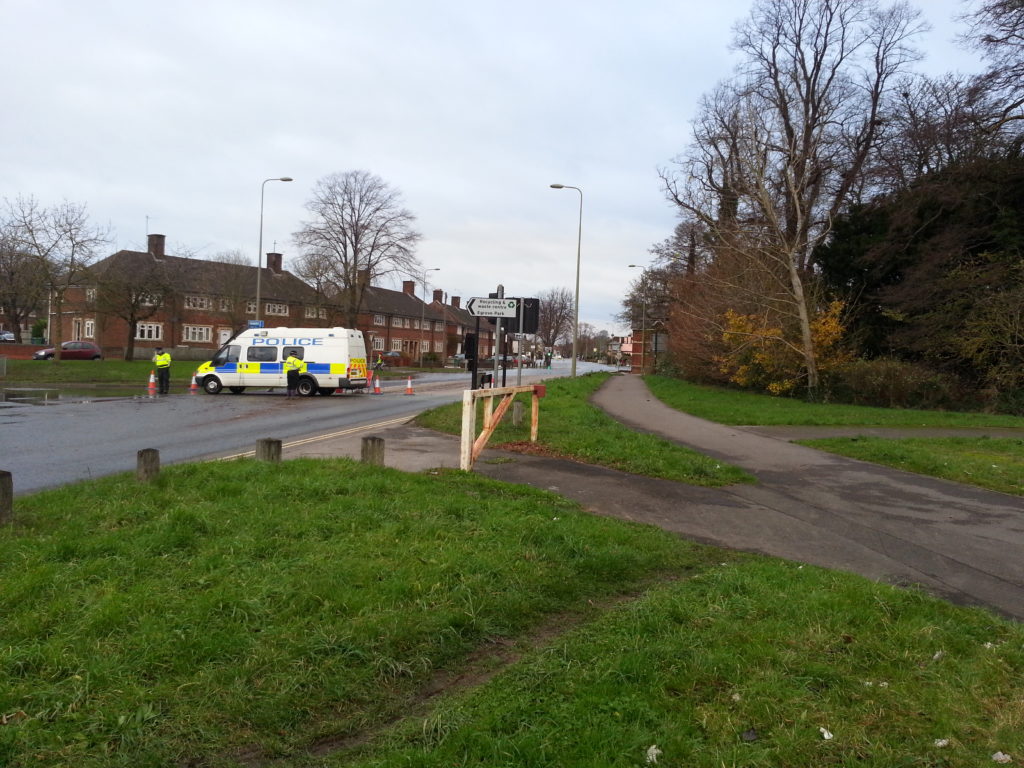
I had to weave my way back and forth around the cyclepaths nearest my house, and – on a couple of ocassions – get off the bike and wade it through: I’d considered riding through some of the larger puddles – my mean pedal-ground clearance is about as high as the top of my boots, anyway – until I met a soaked cyclist coming the other way: he’d become disbalanced going over a submarine kerbstone and fallen into the freezing water. Seeing that quickly made me choose the safer strategy!

Alongside the lake was one of the most flood-damaged areas, but heavy barriers had been erected and pumping engines were working at returning the water to the “right” side of them. The lake bridge was completely closed off: it looked like it might be traversable, but if the water gets any higher, it won’t be.

I took the cycle route through Hinksey Park in order to avoid the flooded parts of Abingdon Road, which runs parallel, but I’m not sure that it was much better. In the photo above, you’d be forgiven for thinking that you’re looking at the lake… but in actual fact, the lake is behind me: that’s the playing fields. You can just about make out the line down the middle of the cycle path, through the murky water.

Pressing on, I came to the Thames Path, which my route typically follows for a short distance to the footbridge into the city centre. And that’s when I realised quite how high the river really is.

By the time I found myself on a footpath with a current, I realised that my route might need a little bit of a rethink. With the bridge I was aiming for just ahead, though, I was able to double-back and cut through an alleyway (between some seriously at-risk houses), duck under a couple of “footpath closed” barriers, and splash out to the bridgehead.
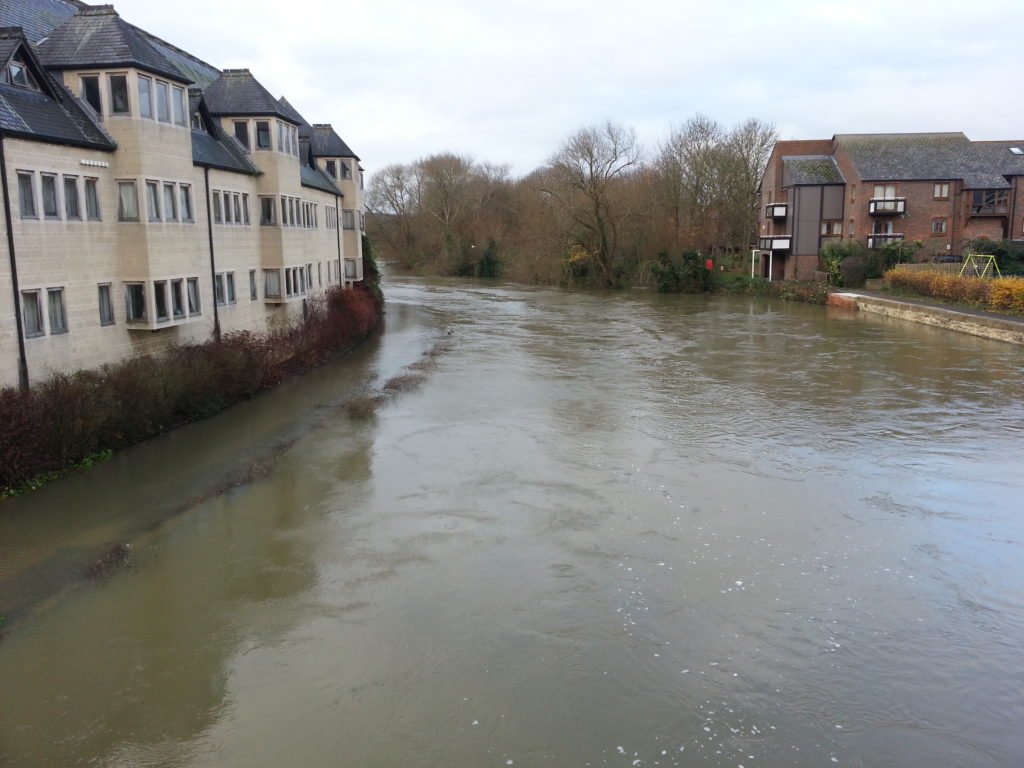
By the time I was on the higher, better-reinforced East bank for the river, things began to improve, and within a few minutes I was right in the city centre. There, you wouldn’t know that, only a short distance away, a significant number of streets were underwater. To sit in the dry, on Broad Street, in the middle of Oxford, it seems strange to think that on the edge of town, people are being evacuated from their homes.
Further reading:
- Flood warning for Kennington, from the Environment Agency (looks like we’re just on the right side of the road not to be included in the “flood warning area”).
- “Live” upstream and downstream water level measurements at nearby Iffley Lock (there’s a beautiful moment in the graphs for yesterday morning when they clearly started using the lock itself to “dump” water downstream, occasionally bringing the level to within the typical range.
- Video of evacuations from Botley
- Jack FM’s Traffic Reports have an up-to-date list of roads closed as a result of flooding
Network Rail engineers near Redbridge Park & Ride sit in their van as it sinks into a field. I feel really sorry for them!
This link was originally posted to /r/oxford. See more things from Dan's Reddit account.
The original link was: http://i.imgur.com/vKk6Wh.jpg
Doing my bit. Now if only I could persuade a few billion other men to do the same.
This self-post was originally posted to /r/overpopulation. See more things from Dan's Reddit account.
No children. My vasectomy’s next week. Took a little persuasion to get my doctor to sign off on the operation, but got there in the end.
My story (in a self-post because I don’t want to look like I’m reaping karma for doing something that billions of men should consider).
Thanks for helping to remind people why this kind of stuff is important, /r/overpopulation.
11 years, 11 days.
This is a repost promoting content originally published elsewhere. See more things Dan's reposted.
The escape is imminent. I am leaving Aberystwyth (with Jim soon to join me) for Gloucestershire. I am greatly looking forward to several things: Access to proper shopping More live music More comedy Multiscreen cinemas! Having disposable income Being nearer to some of my closest friends There are, of course, things that I’ll miss: The…
Claire and I broke up in 2009, and I left Aberystwyth shortly afterwards. It look her a little while to complete her PhD and be ready to leave, herself, when she made this blog post.
The Snip, Part 1
I’d like to start with a joke:
Is there a difference between men and women?
Yes! There’s a vas deferens.
What’s no joke, though, is the human population explosion. There’re just too damn many of us, as I explained last year. That’s the primary reason behind my decision, held for pretty-much the entirety of my adult life, to choose not to breed.

I’m fully aware that the conscious decision to not-breed by a single individual – especially in the developed world – makes virtually no difference to the global fate of humanity. I’m under no illusion that my efforts as a vegetarian are saving the world either. But just like the voter who casts a ballot for their party – even though they know it won’t make a difference to the outcome of the election – I understand that doing the right thing doesn’t necessarily have to have a directly quantifiable benefit.

That’s why I’m finally taking the next obvious step. Next month, after literally years of talking about it, I’m finally going to put my genitals where my mouth is (hmm… maybe that wasn’t the best choice of words)! Next week, I’m getting a vasectomy.

I first asked a doctor about the possibility of vasectomy about a decade ago. He remarked upon my age, and said – almost jokingly – “Come back in ten years if you still feel the same way!” I almost wish that I still had the same GP now, so that I could do exactly that. Instead, I spoke about a year ago to my (old) GP here in Oxford, who misled me into thinking that I would not be able to get the surgery on the NHS, and would have to have it done privately. Finally, a second doctor agreed to sign off their part of the consent form, and I was good to go. The secret, it seems, is persistence.

I’m sure that this is a decision that won’t be without it’s controversies. And believe me: over the course of the most-of-my-life-so-far that I’ve hinted at or talked about doing this, I’m pretty sure I’ve heard all of the arguments. Still: I feel like I ought to pick up on some of the things I’ve heard most-often –

What if you change your mind?
Even despite medical advances in recent decades in vasectomy reversal, vasectomy should still be considered a “one way trip”. Especially when I was younger, people seemed concerned that I would someday change my mind, and then regret my decision not to spawn children.
I suppose that it’s conceivable – unlike my otherwise potential offspring – but it’s quite a stretch, to believe that I might someday regret not having children (at least not biologically: I have no problem with adopting, co-parenting, fostering, or any number of other options for being involved in the upbringing of kids). I honestly can’t see how that’d come about. But even if we do take that far-fetched idea: isn’t it equally possible that somebody might ultimately regret having children. We take risks in our lives with any choice that we make – maybe I’ll someday regret not having taken my degree in Law or Chemistry or Rural Studies. Well then: c’est la vie.
Do you just not like children?
Children are great, and I’d love to get the chance to be involved in raising some. However, I don’t define myself by that wish: if I never have the opportunity to look after any kids, ever, then that wouldn’t be the worst thing in the world: I’d just spend my years writing code in a house full of cats. I have no doubt that raising children is great (for many people), but just like there are plenty of people for whom it’s not great, there are also plenty of people – like me – who could be happy either way. No biggie!
There are those who have said that this laid-back “take it or leave it” approach, especially when coupled with the more-recent act of rendering myself infertile, will make me less attractive to women. Leaving aside the implicit sexism in that claim, wouldn’t a fair retort be to point out that a woman who is looking for monogamous breeding probably isn’t my “type” to begin with!
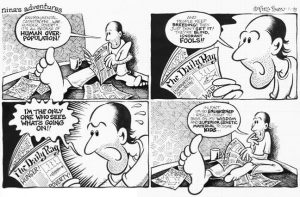
But you should be breeding?
This argument’s usually based on the idea that I’m somehow genetically superior and that my children wouldn’t be such a strain on the world as somebody else’s, or that mine would have a significantly better-than-average chance of curing cancer, solving world hunger, or something.

And let’s face it, any child of mine would be just as likely to be the one to build a really big bomb. Or create a super-virus. Or just engineer the collapse the world’s economies into a prehistoric barter economy in a technophobic future anarchy. Attaboy.
In any case, I’m pretty sure that my personal contribution to the betterment of the world ought not to be a genetic one. I’d like to make a difference for the people who are around right now, rather than hypothetical people of the future, and I’d far rather leave ideas in my wake than a handful of genes. I’m sure that’s not the case for everybody, but then – it doesn’t have to be.

Or are there some arguments that I’ve missed? If you’re among the folks who feel really strongly about this, then you’ve got about seven days to make them, and then it’s off to the clinic for me! Just remember: what’s right for me isn’t necessarily what’s right for you, and vice-versa. Just because I use Emacs doesn’t mean that some other, inferior text editor might not be the right choice for you.
I wonder what my surgeon might say to the possibility of me live-tweeting the process? Would anybody be interested? (I promise not to include any photos.)
(with thanks to Nina Paley for permission to use the comics)
TIL that minutes before the Halifax Explosion (the largest ever non-nuclear, man-made explosion), a dispatcher named Vince Coleman returned to his station to send a warning telegram, saving 300 lives at the cost of his own.
This link was originally posted to /r/todayilearned. See more things from Dan's Reddit account.
The original link was: https://en.wikipedia.org/wiki/Vince_Coleman_(train_dispatcher)
Patrick Vincent Coleman
Patrick Vincent Coleman (13 March 1872 – 6 December 1917) was a train dispatcher for the Canadian Government Railways (formerly the ICR, Intercolonial Railway of Canada) who was killed in the Halifax Explosion, but not before he sent a message to an incoming passenger train to stop out of range of the explosion. Today he is remembered as one of the heroic figures from the disaster.
On the morning of 6 December 1917, the 45-year-old Coleman and Chief Clerk William Lovett were working in the Richmond station, surrounded by the railway yards near the foot of Richmond Street, only a few hundred feet from Pier 6. From there, trains were controlled on the main line into Halifax. The line ran along the western shore of Bedford Basin from Rockingham Station to the city’s passenger terminal at the North Street Station, located a mile to the south of Richmond Station. Coleman was an experienced dispatcher who had been commended a few years earlier for helping to safely stop a runaway train.
At approximately 8:45 a.m., there was a collision between SS Mont-Blanc, a French munitions ship carrying a cargo of high explosives, and a Norwegian vessel, SS Imo. Immediately thereafter Mont-Blanc caught fire, and the crew abandoned ship. The vessel drifted from near the mid-channel over to Pier 6 on the slack tide in a matter of minutes and beached herself. A sailor, believed to have been sent ashore by a naval officer, warned Coleman and Lovett of her cargo of high explosives. The overnight express train No. 10 from Saint John, New Brunswick, carrying nearly 300 passengers, was due to arrive at 8:55 a.m. Before leaving the office, Lovett called CGR terminal agent Henry Dustan to warn him of a burning ship laden with explosives that was heading for the pier. After sending Lovett’s message, Coleman and Lovett were said to have left the CGR depot. However, the dispatcher returned to the telegraph office and continued sending warning messages along the rail line as far as Truro to stop trains inbound for Halifax. An accepted version of Coleman’s Morse code message reads as follows:
“Hold up the train. Ammunition ship afire in harbour making for Pier 6 and will explode. Guess this will be my last message. Good-bye boys.”
The telegraphed warnings were apparently heeded, as the No. 10 passenger train was stopped just before the explosion occurred. The train was halted at Rockingham Station, on the western shore of Bedford Basin, approximately 6.4 kilometres (4.0 mi) from the downtown terminal. After the explosion, Coleman’s message, followed by other messages later sent by railway officials who made their way to Rockingham, passed word of the disaster to the rest of Canada. The railway quickly mobilized aid, sending a dozen relief trains with fire and medical help from towns in Nova Scotia and New Brunswick on the day of the disaster, followed two days later by help from other parts of Canada and from the United States, most notably Boston. Even though Lovett had left the station, both he and Coleman were killed in the explosion.
Although historians debate whether Coleman’s initial message actually contributed to stopping the No. 10 train, there is some documented evidence to indicate it did. No. 10’s Conductor Gillespie reported to the Moncton Transcript that although running on time, “his train was held for fifteen minutes by the dispatcher at Rockingham.”
Vince Coleman was also the subject of a Heritage Minute and was a prominent character in the CBC miniseries Shattered City: The Halifax Explosion. The Heritage Minute and other sources contain historical inaccuracies in that Coleman is shown warning others in the area surrounding the depot station of the impending explosion. In reality the Richmond Station was surrounded by freight yards. Another error is the exaggeration of the number of passengers aboard the Saint John train. The four-car overnight passenger train contained a maximum of 300 people, not 700 as claimed in the Heritage Minute. The warning message is also changed. Coleman’s telegraph key, watch and pen are on display in the Halifax Explosion exhibit at Halifax’s Maritime Museum of the Atlantic.
Coleman is interred at Mount Olivet Cemetery in Halifax, at the intersection of Mumford Road with Joseph Howe Drive. He was survived by his wife Frances, who lived until 1970. A street is named after him in the Clayton Park neighbourhood of Halifax, and in 2007 a section of Albert Street near his old home was renamed Vincent Street. A condominium near Mount Olivet Cemetery on Bayer’s Road is named The Vincent Coleman, also in his honour.
Coleman was inducted into the Canadian Railway Hall of Fame in 2004. A Halifax harbour ferry was named Vincent Coleman, by popular vote in the spring of 2017. The ferry was dedicated and officially entered service in a ceremony at the Halifax ferry terminal on March 14, 2018.
Wikipedia
Days Like Weeks
You know how when your life is busy time seems to creep by so slowly… you look back and say “do you remember the time… oh, that was just last week!” Well that’s what my life’s been like, of late.
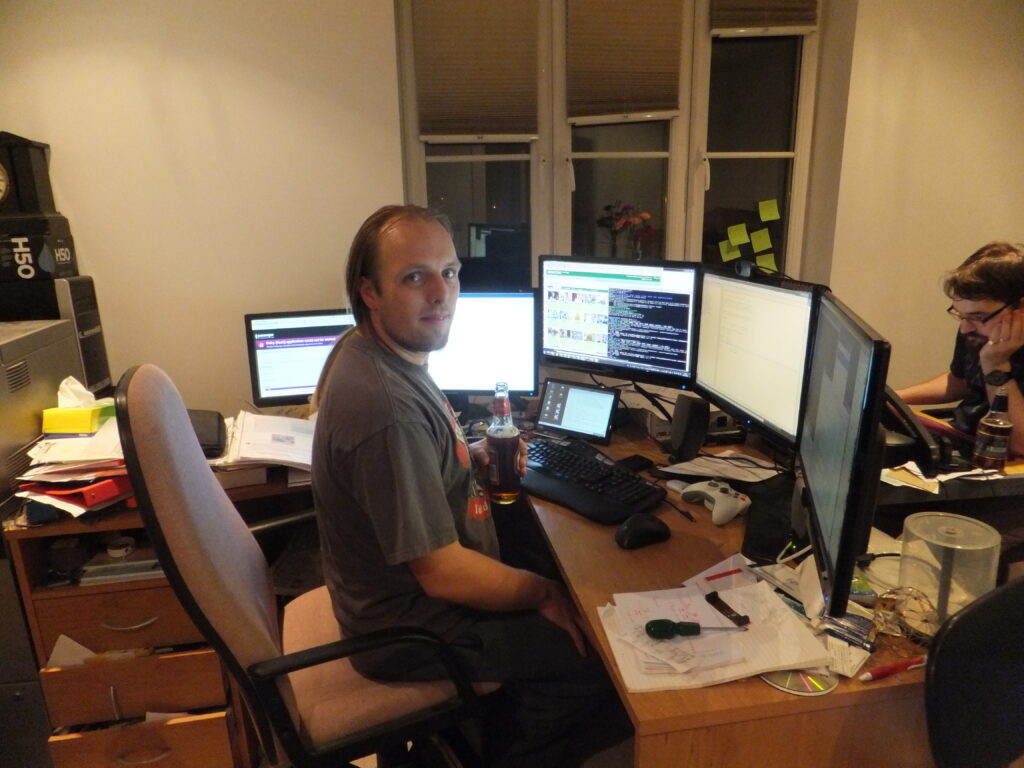
There was Milestone: Jethrik and the Three Rings Conference, of course, which ate up a lot of my time but then paid off wonderfully – the conference was a wonderful success, and our announcements about formalising our non-profit nature and our plans for the future were well-received by the delegates. A slightly lower-than-anticipated turnout (not least because of this winter ‘flu that’s going around) didn’t prevent the delegates (who’d come from far and wide: Samaritans branches, Nightlines, and even a representative from a Community Library that uses the software) from saying wonderful things about the event. We’re hoping for some great feedback to the satisfaction surveys we’ve just sent out, too.

Hot on the heels of those volunteering activities came my latest taped assessment for my counselling course at Aylesbury College. Given the brief that I was “a volunteer counseller at a school, when the parent of a bullied child comes in, in tears”, I took part in an observed, recorded role-play scenario, which now I’m tasked with dissecting and writing an essay about. Which isn’t so bad, except that the whole thing went really well, so I can’t take my usual approach of picking holes in it and saying what I learned from it. Instead I’ll have to have a go at talking about what I did right and trying to apply elements of counselling theory to justify the way I worked. That’ll be fun, too, but it does of course mean that the busy lifestyle isn’t quite over yet.
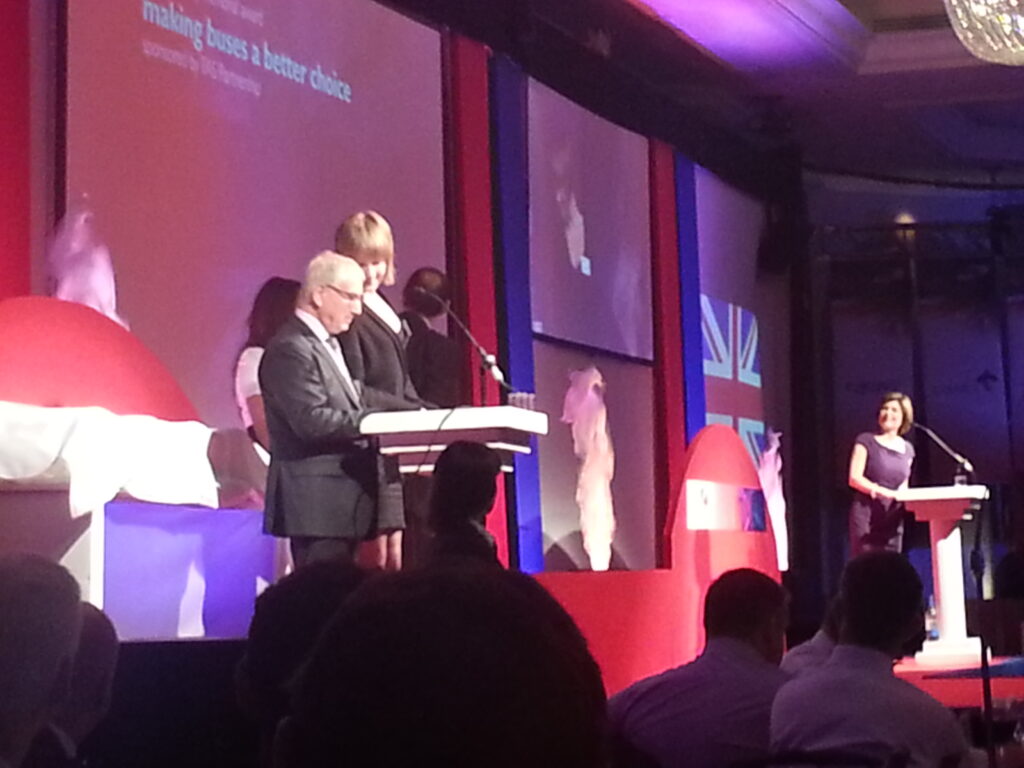
And then on Tuesday I was a guest at the UK Bus Awards, an annual event which my dad co-pioneered back in the mid-1990s. I’d been invited along by Transaid, the charity that my dad was supporting with his planned expedition to the North Pole before he was killed during an accident while training. I was there first and foremost to receive (posthumously, on his behalf) the first Peter Huntley Fundraising Award, which will be given each year to the person who – through a physical activity – raises the most money for Transaid. The award was first announced at my father’s funeral, by Gary Forster, the charity’s chief executive. Before he worked for the charity he volunteered with them for some time, including a significant amount of work in sub-Saharan Africa, so he and I spent a little while at the event discussing the quirks of the local cuisine, which I’d experienced some years earlier during my sponsored cycle around the country (with my dad).
So it’s all been “go, go, go,” again, and I apologise to those whose emails and texts I’ve neglected. Or maybe I haven’t neglected them so much as I think: after all – if you emailed me last week, right now that feels like months ago.
Long tongue! [x-post /r/funny]
This link was originally posted to /r/Cows. See more things from
Dan's Reddit account.
The original link was: http://i.imgur.com/RzBit.jpg
Conference Preparations
Right now, Three Rings seems to be eating up virtually all of my time. It’s hardly the first time – I complained about being incredibly busy with Three Rings stuff just a couple of years ago, but somehow right now it’s busier than ever. There’s been the Milestone: Jethrik release, some complications with our uptime when our DNS servers were hit by a DDoS attack, and – the big one – planning for this weekend’s conference.
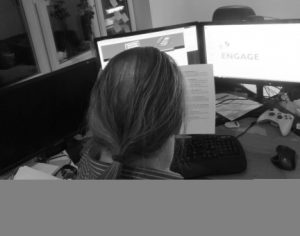
The Three Rings 10th Birthday Conference is this weekend, and I’ve somehow volunteered myself to not only run the opening plenary but to run two presentations (one on the history of Three Rings, which I suppose I’m the best person to talk about, and one on being an awesome Three Rings Administrator) and a problem-solving workshop. My mind’s been on overdrive for weeks, and I’m pretty sure I’m not even the one working the hardest (that honour would have to go to poor JTA).
Still: all this work will pay off, I’m sure, and Saturday will be an event to remember. I’m looking forward to it… although right now I’d equally happily spend a week or two curled up in bed under a blanket with a nice book and a mug of herbal tea, thanks.
In other news: Matt P‘s hanging out on Earth at the moment, (on his best behaviour I think) while Ruth, JTA and I decide if we’d like to live with him for a while. So far, I think he’s making a convincing argument. He’s proven himself to be house trained (he hasn’t pooped on the carpet even once) and everything.
Maybe I’m just being a whole-wit, but I don’t understand this Double Earth thing. ELI10.
This self-post was originally posted to /r/DoubleWorldProblems. See more things from Dan's Reddit account.

